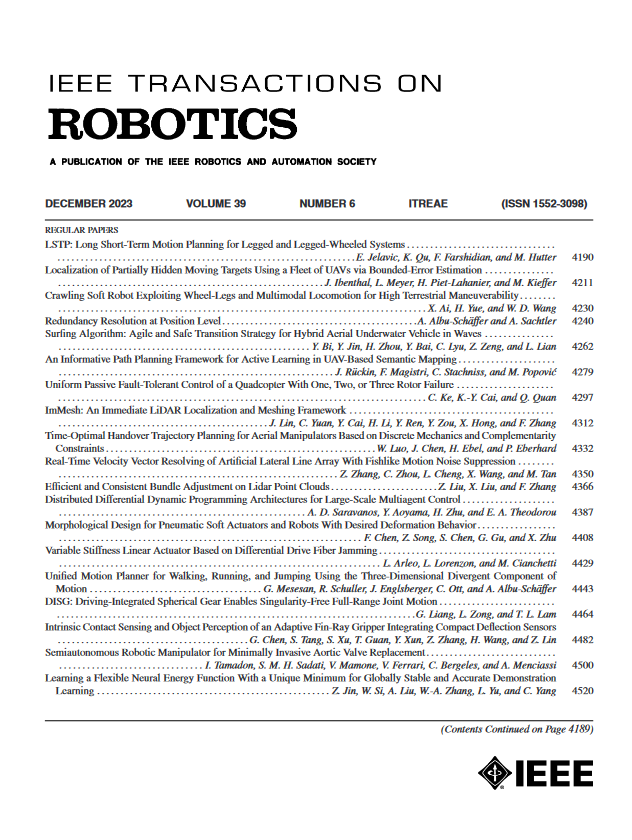CornerVINS: Accurate Localization and Layout Mapping for Structural Environments Leveraging Hierarchical Geometric Representations
IF 10.5
1区 计算机科学
Q1 ROBOTICS
引用次数: 0
Abstract
A compact and consistent map of surroundings is critical for intelligent robots to understand their situations and realize robust navigation. Most existing techniques rely on infinite planes, which are sensitive to pose drift and may lead to confusing maps. Toward high-level perception in indoor environments, we propose CornerVINS, an innovative RGB-D inertial localization and layout mapping method leveraging hierarchical geometric features, i.e., points, planes, and box corners. Specifically, points are enhanced by fusing depth information, and planes are modeled as bounded patches using convex hulls to increase their discriminability. More importantly, box corners, lying at the intersection of three orthogonal planes, are parameterized with a 6-D vector and integrated into the extended Kalman filter for the first time. We introduce a hierarchical mechanism to effectively extract and associate planes and corners, which are considered as layout components of scenes and serve as long-term landmarks to correct camera poses. Extensive experiments prove that the proposed box corners bring significant improvements, enabling accurate localization and consistent layout mapping at low computational cost. Overall, the proposed CornerVINS outperforms state-of-the-art systems in both accuracy and efficiency.CornerVINS:利用层次几何表示的结构环境的精确定位和布局映射
紧凑一致的环境地图是智能机器人理解环境、实现鲁棒导航的关键。大多数现有的技术都依赖于无限平面,这对姿态漂移很敏感,可能会导致地图混乱。针对室内环境的高级感知,我们提出了CornerVINS,这是一种创新的RGB-D惯性定位和布局映射方法,利用分层几何特征,即点、面和盒角。具体来说,通过融合深度信息来增强点,并且使用凸包将平面建模为有界补丁以增加其可分辨性。更重要的是,位于三个正交平面交点的框角首次用6维矢量参数化,并集成到扩展卡尔曼滤波器中。我们引入了一种分层机制来有效地提取和关联平面和角,这些平面和角被认为是场景的布局组件,并作为校正相机姿势的长期地标。大量的实验证明,所提出的盒角定位方法具有显著的改进效果,能够以较低的计算成本实现准确的定位和一致的布局映射。总的来说,拟议的CornerVINS在精度和效率方面都优于最先进的系统。
本文章由计算机程序翻译,如有差异,请以英文原文为准。
求助全文
约1分钟内获得全文
求助全文
来源期刊

IEEE Transactions on Robotics
工程技术-机器人学
CiteScore
14.90
自引率
5.10%
发文量
259
审稿时长
6.0 months
期刊介绍:
The IEEE Transactions on Robotics (T-RO) is dedicated to publishing fundamental papers covering all facets of robotics, drawing on interdisciplinary approaches from computer science, control systems, electrical engineering, mathematics, mechanical engineering, and beyond. From industrial applications to service and personal assistants, surgical operations to space, underwater, and remote exploration, robots and intelligent machines play pivotal roles across various domains, including entertainment, safety, search and rescue, military applications, agriculture, and intelligent vehicles.
Special emphasis is placed on intelligent machines and systems designed for unstructured environments, where a significant portion of the environment remains unknown and beyond direct sensing or control.
 求助内容:
求助内容: 应助结果提醒方式:
应助结果提醒方式:


